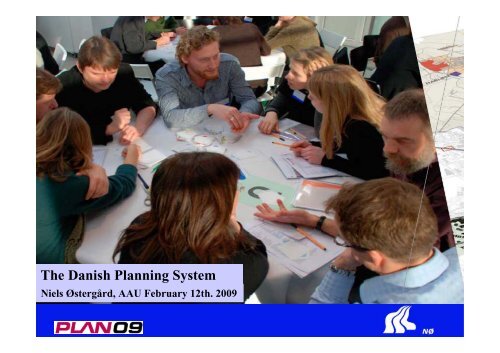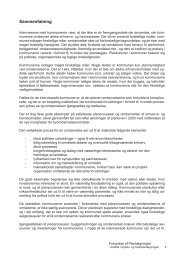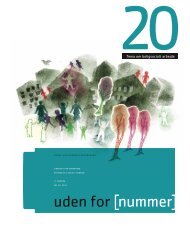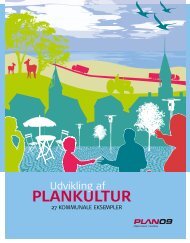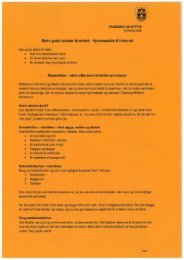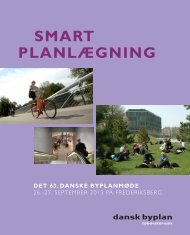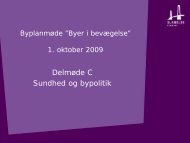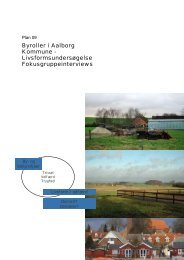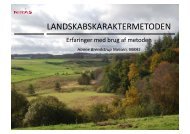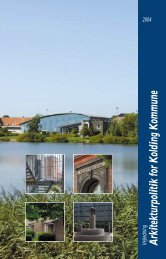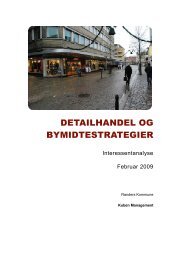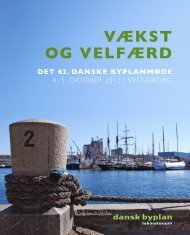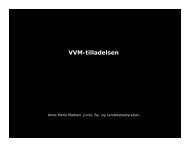The Danish Planning System
The Danish Planning System
The Danish Planning System
- No tags were found...
Create successful ePaper yourself
Turn your PDF publications into a flip-book with our unique Google optimized e-Paper software.
<strong>The</strong> <strong>Danish</strong> <strong>Planning</strong> <strong>System</strong>Niels Østergård, AAU February 12th. 2009
Denmark at a glanceBounded by waterapart from 64 kmFlat agricultural landPopulation density127 per km 2<strong>The</strong> large ”H”Two new bridges andone more decided
Urban development since 19601960 2000Characteristicdevelopment trends:• Expansion (4 times)• urban sprawl• great distances requiredfor daily functions• high energyconsumption• separation of urbanfunctions
Population and urban structure5,5 mill. inhabitants5 largets cities are:Copenhagen, Århus,Odense, Ålborg andEsbjerg1/3 lives in the GreaterCopenhagen area
Commuting and the infrastructure<strong>The</strong> flow of commuting in 2002
<strong>The</strong> 2006 National <strong>Planning</strong> Report<strong>The</strong> new map of Denmark5 types of settlementregions:• Greater Copenhagen• <strong>The</strong> rest of Zealand• Eastern Jutland• Town regions• Small town regions
<strong>The</strong> new administrative map 2007• From 271 to 98 municipalities• From 14 counties and theGreater CopenhagenAuthority (HUR) to 5 regions• 7 new national environmentcentres
<strong>The</strong> local government reform• Oct 2002 to Jan 2004 Structure Commission.Analysis og models – but without proposals,3 month hearing27th. April 2004 <strong>The</strong> Government’s proposal• May -June 2004 Political negotiations• Autumn 2004 Legislation prepared (50different acts)• December 2004 Hearing• December 2004 Municipalities’ proposals foramalgamation• 8th. Feb 2005 Parliamentary election• 24th Feb. 2005 Legislation proposals to Parliament• June 2005 Legislatation approved• November 2005 Local government elections (newmunicipalities and regions)• 2006 Transitional arrangement takeseffect
<strong>The</strong> planning act reform 2007BeforeNational planningAfterStrengthened national planning12 Regional plans 5 Regional spatial developmentplans271 Municipal plans 98 Municipal plans1300 Local plans p.a. No change for Local plansTransitional arrangement 2006 - 2009
Overview of national interests• Every 4th. year• Specific definition of municipal latitude• No new stipulations but overview oflegislation, national reviews and actionplans etc.• Prepared with other relevant ministriesand in spirit of dialogue with the <strong>Danish</strong>Local Government Association (KL)• <strong>The</strong> aim is to avoid vetoes• <strong>The</strong> Minister for the Environment has aduty to veto plans, which are not inaccordance with national interests
<strong>The</strong> Greater Copenhagen Region,special provisions in the Spatial <strong>Planning</strong> Act<strong>The</strong> 2005 Regional Plan is replaced by Finger Plan 2007 + 34minicipal plans
Greater Copenhagen Region1 mill. workplaces1.8 mill. inhabitants• Central cities: 1/3• Inner suburban Ring: 1/3• Outer suburban Ring: 1/3Five provincial towns:Elsinore: pop. 35,000Hillerød: pop. 29,000Frederikssund: pop.15,000Roskilde: pop. 46,000Køge: pop. 34,500
<strong>The</strong> 2007 Finger PlanSpecifik contents:• 4 geographical zones are shown ona map, i.e. town fingers withpotential for new urban areas andthe extent of the green wedges• Makes adjustments to the stationproximity principle• Municpal plans must containprovisions for phased developmentof new urban zone negotiated withthe Ministry of the Environment• Reservations for transportinfrastructure and the transportcorridor etc.
<strong>The</strong> eastern Jutland urban corridor –following up on the National <strong>Planning</strong> ReportDialogue project-concerning sustainable urbandevelopment:• 1 mill. population – strong growth• 17 municipalities, 2 regions, 2ministries• Phase 1: Analysis of functions• Phase 2: Vision/Mission• Phase 3: 3-4 alternative outline plans• Phase 4: Conclusions
Urban policy initiativeby the Minister of the Environment<strong>The</strong> compact town<strong>The</strong> healthy town<strong>The</strong> green town<strong>The</strong> blue town
<strong>The</strong> 5 regional spatial development plans• New type of plan: <strong>The</strong>Regional Council’s vision• Binds regional strategiestogether- Business development- Employment and education- Nature and the environment- Public transport etc.• Maps– but no precise land use reservations
<strong>The</strong> role of munipal planningStrategic Plan 2007+ Local Agenda 21Visions and goalsRegionalactivitiesMunicipal Plan 2009Centralgovernmentactivities<strong>The</strong> RuralDevelopment ProgrammeWater resource plansAndNatura 2000 plans
From strategy to municipal plan2007• Strategy• Public hearingand debate2008 – 2009• Main structure• Guidelines• Framework for local planning• Public hearing and debate
Policy for Retail DevelopmentGoals:Shops in the core of the townsVariety of shops in small andmedium sized townsSustainable retail structureAccess for pedestrians publictransportGeneral limits:3500 m 2 for general shops and2000 m 2 for speciality shops
Urban policy principlesBrown field sites and new developmentAim: urban quality, density andreduced need for urban expansionDesignated sites in Municipal PlanReuse of brown field sitesSpecific public/private regenerationpartnershipPossibility for a future landownerassociationNew development - mix of urbanfunctions
Social regeneration projectsAvedøre Stationsby (special legislation)Problems:• criminality• unemployment• high degree ofremoval• conflicts betweenetnic groups• increasing rents• vandalism• run-down publicareas
<strong>The</strong> local plansMandatory before largeprojects or substantialchanges in surroundingsImplement stipulations ofregional and municipal plansLegally binding for propertyownersPublic participation
<strong>The</strong> urban-rural zoning systemUrban zoneVillage delimitationSummer cottageareaLocal plan in ruralarea
Rural zone administrationA rural zone permit is required toparcel out land, construct buildingsor change the land usePurpose:• Prevention of random buildingand construction• Protection of landscape assets• Protection af recreational assets• Protection of agriculture andforestry• Support for the rules andframework of municipal plans• Special rules for former farmbuildings
Plan09: Partnership-programme 2006-09Support to the municiplal planning proces. Aims at:• Valuable urban environments and attractive landscapes• Political ownership and commitment• Specialist professional and innovative planning culture in both the publicand the private sectorFacts• <strong>The</strong> project is a partnership between <strong>The</strong> Realdania Foundationand <strong>The</strong> Ministry of <strong>The</strong> Environment• <strong>The</strong> total budget framework 2006-2009 is 50 mio. kr.
On the road to the municipal plan 2009Strategic Plan 2007Visions and goalsRegionalactivitiesMunicipal Plan 2009Centralgovernmentactivities<strong>The</strong> RuralDevelopment ProgrammeWater resource plansAndNatura 2000 plans
26 demonstration projectsin 40 municipalities• Urban renewal• Urban pattern• Digital municipal plans• Adaptation to climate change in thecountryside• Green space near towns• Retailing in smaller towns• Business alongside motorways• Housing policy in the municipal plan• <strong>Planning</strong> culture in the planningdepartment
<strong>The</strong> urban planning paradoxDense cities• reduce the globalenvironmental burden• increase localenvironmental problemsUrban Sprawl• increases the globalenvironmental burden• reduces localenvironmental problems
<strong>The</strong> site and the building<strong>The</strong> town planner and the architect
<strong>The</strong> local plan delivers ”<strong>The</strong> site”!Ny Tøjhusgrunden Carlsberg
<strong>The</strong> municipal plan delivers the policyand the framework!<strong>The</strong> municipal planningdepartment needs tomaster many disciplinesCommi• Spatial planners and specialists deliver the competences• <strong>Planning</strong> culture is a symbiosis of the actors’ sense of values,competences and interests• Thus politicians become part of the planning culture
Thanks for your attention !www.blst.dk(<strong>The</strong> Agency for Spatial and Environmental<strong>Planning</strong>)www.commin.org(<strong>The</strong> Baltic Spatial Conceptshare)www.plan09.dk(An partnershipprojekt 2006-2009)http://commin.org/upload/Denmark/Reform_of_the_<strong>Planning</strong>_Act.doc(Article by Niels Østergård)http://www.blst.dk/NR/rdonlyres/4D850FA0-B5CC-4892-AD6A-FAF72DAC5FBF/49285/<strong>Planning</strong>_260907_NY.pdf


